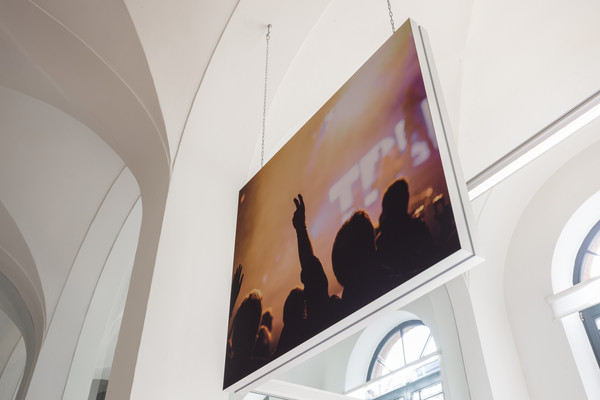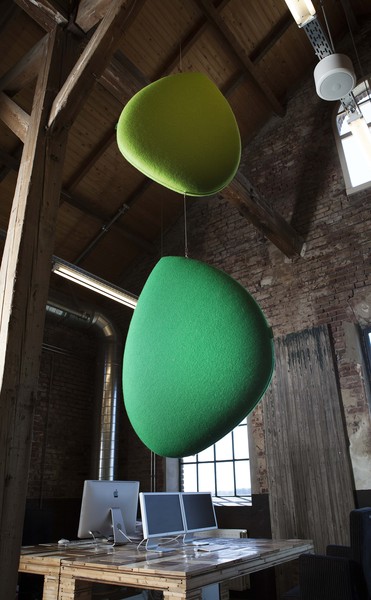Acoustic ceiling panels
- All
- Acoustic panels Acoustic wall panels Ceiling panels Desk screens Acoustic partitions Columns Soundleaves Soundproof booths
How to optimize the acoustics of a room ?
Optimizing acoustics isn't just about installing a few panels on the ceiling. It's about considering the entire space: floor, walls, furniture, and of course, the ceiling. An excess of hard surfaces like concrete, glass, or plaster promotes sound reverberation and amplifies ambient noise.
Here are some key elements for effective acoustic treatment:
Analyze the space: each room has its own unique acoustic challenges depending on its size, furniture, and use (open-plan office, home theater, restaurant, concert hall, etc.).
Mix sound-absorbing surfaces: combine wall and ceiling panels for even absorption.
Play with placement: suspended or freestanding panels can be placed above the noisiest areas (tables, workstations, bars, stages).
Consider aesthetics: architectural integration is essential. The panels must complement the style and interior design.
What types of acoustic panels are available?
There is a wide range of acoustic ceiling panels, each designed to meet specific needs. The choice depends on the function of the space, the noise level to be addressed, and the desired aesthetic.
Fixed wall and ceiling panels
Assembled directly on-site (such as COUSTceiling or ARTceiling).
Offer a sleek and seamless finish, ideal for renovation projects or public spaces.
Easily integrate technical systems (lights, cables, sensors).
Suspended panels or baffles
Hanged by cables or chains, they create a floating effect.
Highly effective for high ceilings or large spaces where sound tends to travel.
The COUSTbaffle model, for example, absorbs sound from both sides, thus doubling its effectiveness.
Acoustic islands
Panels installed in localized areas, often above specific zones (tables, platforms, work areas).
They allow for great flexibility in layout and targeted noise reduction.
Acoustic ceiling tiles or suspended ceilings
Integrated into a suspended ceiling structure.
A practical and discreet solution, often used in commercial or educational buildings.
What are the advantages of acoustic panels ?
Installing acoustic panels on the ceiling is not just about comfort: it's a real investment in quality of life and the performance of spaces.
Improved acoustic comfort
Reduction of reverberation and noise pollution.
Increased intelligibility of conversations, even in public spaces such as restaurants or open-plan offices.
Reduction of auditory fatigue related to ambient noise.
Aesthetics and design
Wide choice of fabrics, colors, and custom prints.
Acoustic panels become decorative elements, capable of transforming a ceiling into an architectural work of art.
A "floating" visual effect for suspended or island models.
Versatile Application
Suitable for both modern buildings and restoration projects.
Custom solutions that integrate seamlessly into any type of space: offices, meeting rooms, home theaters, schools, restaurants, etc.
Technical Performance
High-quality sound absorption (Class A, α value = 1 from 300 Hz).
Some models also offer additional thermal insulation.
Fire resistance (A1 content, B-s1-d1 tensioned fabric), meeting safety standards.
How to Install Acoustic Panels ?
The installation of acoustic ceiling panels varies depending on the type chosen. Some systems are fixed directly to the ceiling, while others are suspended by cables or integrated into a false ceiling.
The most common installation methods:
Direct fixing: panels like COUSTceiling are mounted on-site and secured, ensuring a uniform and durable finish.
Suspended by cables or chains: a solution used for acoustic baffles or suspended islands. It allows you to adjust the height and play with the floating aesthetic.
Integration into a suspended ceiling: practical and discreet, ideal for commercial buildings.
Adhesive or invisible fixings: sometimes used for lightweight tiles or decorative panels.
Practical advice:
Entrust the installation to an acoustics specialist to ensure a correct and effective installation.
Check access to electrical installations (lighting fixtures, speakers, smoke detectors) before installation.
Adapt the layout according to the noisy areas of the room.
What materials for acoustic panels ?
The choice of materials is essential to guarantee optimal sound absorption. COUST acoustic ceiling panels are designed with high-quality construction materials, combining performance and aesthetics.
The main materials used:
Rock wool and glass wool: acoustic core with a minimum density of 80 kg/m³, effective even at low frequencies.
Powder-coated aluminum frame: robust, lightweight, scratch-resistant, and available in several colors (white, aluminum gray, anthracite black).
MDF panel: integrated into some models, it stops noise and enhances absorption capacity.
Trevira CS polyester stretch fabric: smooth finish, resistant to humidity and temperature variations, available in solid colors or with custom prints.
Acoustic fleece: intermediate layer that ensures uniform diffusion and improves the aesthetic appearance.
Technical performance:
Absorption class A (α = 1 from 300 Hz).
Fire rating compliant with standards (content A1, stretch fabric B-s1-d1).
Recyclable and durable materials, suitable for both renovation projects and new construction.
How to reduce noise with panels ?
Noise reduction relies on a balance between absorbent surface area and the strategic placement of acoustic panels. An effectively treated ceiling can completely transform the acoustics of a space.
Keys to optimal noise reduction:
Coverage area: the larger the absorbent surface area, the greater the noise reduction.
Targeted placement: install panels above the noisiest areas (restaurant tables, workstations, conference stage).
Combination of solutions: combine wall and ceiling panels for even absorption.
Choice of panel type: a suspended baffle absorbs sound from both sides, while a fixed ceiling panel primarily reduces direct reverberation.
Results achieved: A noise reduction of 10 to 15 dB, making the sound source appear 3 to 5 times farther away.
Immediate improvement in acoustic quality and sound comfort. Reduced noise pollution and improved speech intelligibility, essential in public spaces.
No results found




